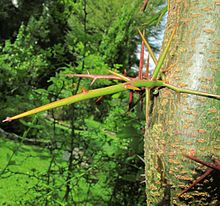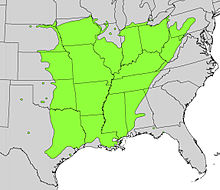American Gleditschie
| American Gleditschie | ||||||||||||
|---|---|---|---|---|---|---|---|---|---|---|---|---|

American Gleditschia ( Gleditsia triacanthos ) |
||||||||||||
| Systematics | ||||||||||||
|
||||||||||||
| Scientific name | ||||||||||||
| Gleditsia triacanthos | ||||||||||||
| L. |
The honey locust ( Gleditsia triacanthos ), also three Thorny Gledischie , honey mandrel , Honeylocust or False Christ mandrel called, is a species in the genus of honey locusts from the family of the Leguminosae (Fabaceae).
description
Vegetative characteristics
The American Gleditschia grows as a deciduous tree and reaches heights of up to 40 meters. It usually forms a funnel-shaped treetop . The bark is grayish-brown, with long, flat longitudinal cracks with age and flaky. The trunk and the branches are thorn-reinforced with large tufts of strong, branched or simple green-reddish to gray-brownish and pointed thorns that are up to 18 cm long, which has led to the name "False Christ thorn". The branches are bent back and forth and usually have three thorns on each bud.
The stalked, alternate leaves are predominantly single, but many are also double-pinnate. The simply pinnate leaves are up to 30 centimeters long and have 14 to 28 narrow-shaped to elliptical, finely notched and rounded-pointed, rounded to blunt leaflets , each 2 to 4 centimeters long; an end leaflet is usually missing. The bipinnate leaves have 8 to 14 leaflets with 10–20 leaflets each. At the end of October the leaves take on a beautiful golden yellow autumn color for a short time.
Generative characteristics
The aromatic flowers are unisexual or hermaphroditic, unicious or dioecious . It can be andromonomy , trimonomic, or gynomonomic. There are male and some with hermaphrodite flowers mixed inflorescences on male plants or there are female and some with hermaphrodite flowers mixed inflorescences on other branches or on other, female plants. The thorns can sometimes transform into inflorescences.
The small, radially symmetrical , greenish flowers of the American Gleditschia are loosely arranged in racemose inflorescences .
The many-flowered male inflorescences are up to 13 cm long. The male flowers are about 5 mm in size and have four to five petals and up to 10 stamens . The fine-haired calyx is bell-shaped, with four to five elliptical-lanceolate lobes. The pistil is rudimentary or absent from the staminate flowers. The female, up to about 9 cm long inflorescences, contain a few four to five-fold flowers. The green-white pistil is tomentose with a heady, yellow-greenish stigma, the ovary is almost sessile. The stamens are much smaller in the female flowers and are abortive.
On the other hand, the narrow, oblong and flattened, leathery legumes that hang down from the trees in autumn and winter are more striking . The legumes, which are around 25 cm long and 2.5 to 4 cm wide, are often irregularly twisted and often wavy or sickle-shaped, curved, and turn red to dark brown when ripe. They can - embedded in a pulp , sweetish pulp - contain up to more than 25 rather hard-shelled seeds. The smooth and light to dark brown, ellipsoidal seeds are about 8-10 mm long and 6.5-7.5 mm wide. The thousand grain mass is about 160–220 grams.
Chromosome number
The number of chromosomes is 2n = 28.
ecology
The American Gleditschie predominantly uses the digestive expansion or so-called endochory as a spreading strategy . The horses and domestic cattle , which were introduced in the 16th century, eat the nutritious legumes and spread the indigestible seeds through the droppings. It is believed that the prairie mammoth as well as mastodons and giant sloths were involved in the spread of this tree species.
distribution
The American Gleditschie is native to the central and eastern parts of the United States . In southern Europe it is often naturalized, in Central Europe, on the other hand, wilderness is rather rare. In Germany she was z. B. found wild in Cologne.
Toxicity
The leaves are considered poisonous, but the seeds and fruits are edible.
The main active ingredient in the leaves is triacanthin , which has been described as poisoning symptoms of cramps and respiratory and circulatory disorders. In fact, no poisoning has been reported from the leaves of the tree.
use
It is completely hardy in Central Europe and is often planted here in parks and grounds. Because of its modesty, the American Gleditschia is occasionally used as a street tree in Central Europe and North America (e.g. in New York City) .
The pulp of the legumes and the seeds are edible. The wood is hard and very durable, but splinters easily.
Varieties
Thornless varieties of this type are now very popular in the American Midwest, where very few tree species thrive. Another use in Central Europe is urban space (streets, parks) with special conditions.
- 'Inermis': a variety in which the trunk and branches are without thorns; the trunk is furrowed deeper than the type. Found in parks and as a street tree.
- 'Sunburst': A shape made in the USA with golden-yellow shoots that soon turn green.
- 'Skyline': A variety that is said to have a stiffer growth and is often used as a street tree.
photos
literature
- Lutz Roth, Max Daunderer, Kurt Kormann: Poisonous plants plant poisons. 6th edition. Nikol, Hamburg 2012, ISBN 978-3-86820-009-6 .
Web links
- Gleditsia triacanthos (honey locust) on cabi.org, accessed December 29, 2017.
- Honey Locust Gleditsia triacanthos on illinoiswildflowers.info, accessed December 29, 2017.
- Thomas Meyer: Data sheet with identification key and photos at Flora-de: Flora von Deutschland (old name of the website: Flowers in Swabia ) .
Individual evidence
- ^ GW Bischoff : Textbook of Botany. Volume 3, First Part, Swiss Beard, 1840, p. 8, limited preview in the Google book search.
- ^ Reports of the German Botanical Society. Volume 90, Bornträger, 1977, p. 311.
- ↑ Vít Bojnanský, Agáta Fargašová: Atlas of Seeds and Fruits of Central and East-European flora. The Carpathian ..., Springer, 2007, ISBN 978-1-4020-5361-0 , p. 299.
- ↑ Seed Information Database at KEW Royal Botanical Gardens, accessed December 29, 2017.
- ^ Gleditsia triacanthos at Tropicos.org. In: IPCN Chromosome Reports . Missouri Botanical Garden, St. Louis
- ^ Bochum Botanical Association: Contributions to the flora of North Rhine-Westphalia from 2013. Yearbook of the Bochumer Botanical Association. Vol. 5, 2014, pp. 130-163 ( PDF 6.4 MB).
- ^ Margaret Mittelbach, Michael Crewdson: Wild New York. Birkhäuser, Basel / Boston / Berlin 1999, ISBN 3-7643-5994-3 .
- ↑ Gleditsia triacanthos at Useful Temperate Plants, accessed December 29, 2017.









